New studies show that, as soon as alcohol taxes are introduced in a country, the number of diseases associated with alcohol consumption significantly decreases, almost instantly. Beer, wine and other types of liquor account for conditions such as liver diseases and oral cancer, as well as alcohol poisoning. The current investigation was published in the American Journal of Public Health.
"The findings are quite astounding. A simple adjustment of the tax rate resulted in a substantial drop in the death rate," said University of Florida College of Medicine scientist, Alexander C. Wagenaar. He said that the study he conducted focused on the state of Alaska, which saw alcohol tax increases in both 1983 and 2002. The rises were more significant than in other states, ranging from 63 cents per gallon in '83 to $1.2 in 2002.
"Alaska was cognizant of its alcohol problems and decided [to] do something meaningful. We are now benefiting from the results of their unique experiment which shows what other states could gain if they were to implement a similar tax increase," the scientist added.
By analyzing relevant data provided to him by Alaska health officials, Wagenaar found that the 1983 alcohol tax increase had the effect of averting some 23 deaths per year, which adds up to about 29 percent of alcohol-related deaths. After the 2002 tax rise, a further 11 deaths were avoided – an additional 11 percent.
He went on to say that "The bottom line is that when we see an intervention that can reduce the death rate of any chronic disease such as cancer or heart disease by a few percent across the whole population, we consider it an important success. In this case, the death rate for alcohol-related diseases dropped suddenly by at least 11 percent and at minimal cost."
He concludes that, if the federal government implements higher taxes nation-wide, then a significant number of alcohol-related deaths could be avoided, at minimal costs. That is to say, the costs of asking more money for the same product are negligible.

 14 DAY TRIAL //
14 DAY TRIAL //